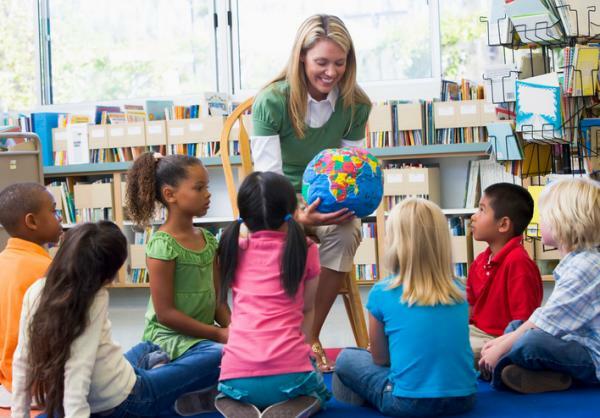
The educational activity has always had a double function: On the one hand, it has dealt with the transmission of knowledge, education in values, norms and attitudes, etc. On the other, he has always carried out in parallel a specific task of helping or guiding the student in the sense of better learning, greater performance, attention individualized to the specific educational needs of each student, concern for personal circumstances, support in making decisions about the future.
The educational orientation attends to the personalized and integrating nature of teaching, since specific people are educated, with particular and individual characteristics. But the whole person is also educated and therefore, it is necessary to integrate the different areas of development and the corresponding educational lines. Keep reading this article about tutorial action in schools in Psychology-Online.
Index
- Guidance and tutoring as a quality factor in education
- Educational orientation, tutorial action and tutorial action plan
- Tutorial action plan
- Difference between tutor and psychologist
- Subjects of the orienting process
- Activities of the educational guidance cabinet
- Conclution
Guidance and tutoring as a quality factor in education.
Among the most novel and notable aspects of the current educational system, is the need and convenience of Guidance as an essential element that favors the quality and improvement of the teaching. In reality, this convenience and necessity of orientation, although it may seem a novelty, is not such. It already has a century of history in some of the most evolved educational systems. In all fairness, it is necessary to affirm that our country has an important guiding tradition for several decades.
As proof of the importance that current legislation attaches to guidance educational let's see some examples:
- LOGSE, Title IV: on the quality of teaching.
-Article 60: “The tutoring and orientation of the students will be part of the teaching function. The educational centers are responsible for coordinating these activities. Each group of students will have a teacher-tutor ”.
- ORGANIC LAW 10/2002, of December 24, on the Quality of Education (LOCE):
-Article 56, point d: "School teachers are responsible for tutoring students to direct their learning, transmitting values and helping them, in collaboration with parents, to overcome their difficulties".
-Article 56, point e: “To the teachers of schools, it corresponds to them, the collaboration, with the services or departments specialized in orientation, in the process of educational, academic and professional orientation of students".
Educational orientation, tutorial action and tutorial action plan.
We understand educational guidance as “a continuous and systematic process of helping the individual, with participation of all members of the educational community, which aims to enable the maximum development of their potentialities ”. The orientation that the student should receive in the educational centers It can be of three types:
- Personal: It is the process of helping a subject so that he reaches sufficient knowledge of himself and the world that surrounds him so that he is able to solve the problems of his life. Its scope of action is made up of ideas, motivations, values and refers to aspects such as relationships with friends, hobbies, possibilities and difficulties of social relationships and, in general, everything that affects behavior human.
- Academic: It could be defined as a process of technical assistance directed to the person in order to improve academic performance, the development of skills and adaptation to the educational center.
- Professional: it is about helping the individual to find a suitable professional occupation for him or her or, once found, to develop it adequately, considering their aptitudes and the needs of the society.
Likewise, educational guidance can be developed in two areas:
- Individual: the one that is given to each student in particular, and takes place mainly in the periodic personal interview with each of the students by the tutor and in some cases by specialized personnel from the Educational Guidance Cabinets (GOE).
- Group: the one that is given to all those who make up a group, and that has very different means: talks, conferences, tests, group dynamics, etc.

Tutorial action plan.
Tutorial or tutoring action is understood to be that set of activities that a teacher performs with a group of students who have especially entrusted, at the same time and in parallel to teaching, being tasks not strictly instructive but taking into account, on all the formative and guidance aspects of the students. The person who performs the tutorial action within a group of students is called a tutor.
Guidance and tutoring are two concepts so interrelated that in many respects they are confused. From a broad and global sense, orientation is a function that exceeds one person. All teachers, tutors and the Educational Guidance Office (G.O.E.) are involved in the orientation. The tutoring is the orientation developed by the tutor with a group of students. That is, mentoring is a subset of mentoring. By this we can understand that, when referring to orientation in general, tutoring is also included.
Mentoring is not an action that takes place in isolation, but must be subject to adequate planning and organization. This programmed educational action is what we call the Tutorial Action Plan (P.AT.). It includes the objectives and lines of action that the tutors will develop with the students of that center throughout the course. Some of these objectives or action blocks general are as follows:
- The welcome at the beginning of the course of each student in the group and in the School.
- The promotion of the participation of the students in their group and in the life of the School.
- Monitoring and coordinating the evaluation process.
- The individualized attention of students.
- Guidance and support in learning.
- Academic and professional orientation.
The PAT (Tutorial Action Plan) It is, therefore, the response that an educational center systematically makes to personalize the teaching-learning process, the framework in which they are specified the criteria and procedures for the organization and operation of the tutorials, and must involve all the components of the educational team: GOE, tutors and faculty. Although the educational orientation is directed fundamentally to the student, in a global way, it also includes the activities aimed at tutors and teachers to help them in the development of their tasks within the specific scope of the centers schoolchildren. This type of guidance is provided by the Center's Guidance Office (G.O.E.), and within it, by the counselor who is the specialist in psychology and pedagogy.

Difference between tutor and psychologist.
Tutor:
- He is basically a teacher.
- Exercises preventive work.
- He takes care of all students, not just those with serious problems.
- It deals with everyday group and learning conflicts.
- It has advisory functions.
- It carries out its work in contact with the student. Live with him daily.
Psychologist / pedagogue:
- They are the guidance experts.
- They perform a clinical diagnostic and healing function.
- They treat the most difficult and problematic students.
- They treat behavioral, social problems, character disorders, etc.
- They are professionals in a specialized technical-advisory action.
Subjects of the guiding process.
The main agents involved in the guidance process in educational centers are:
head of studies
She is the coordinator of orientation in an educational center, exercising her role as a unifier of orientation services and tutors. Some of its functions are:
- Appoint tutors
- Supervise the preparation of the PAT and make proposals on it
- Call coordination meetings with tutors and teachers, proposed by the GOE
- Ensure the planning of the tutoring sessions in the different courses.
The teacher
The teacher, as a mere teacher, is already a counselor. The teaching activity, as a teacher-student relationship, does not end in the mere teacher-teacher activity. The situation of a student in a teaching center, in addition to being an academic situation, is undeniably and primarily a training situation. This is undoubtedly the most worthy aspect of the functions carried out by the teacher.
The tutor
It is the teacher who coordinates the tutorial action of a group of students. Her role will consist of coordinating and developing the tutorial action with her students through close coordination with the entire group of teachers who teach in that group. Some of the activities that the tutor develops within the programming of the tutorial action, Taking into account the six blocks of activities of the PAT, mentioned above, are the following:
- The welcome at the beginning of the course of each student in the group and in the School:
At the beginning of the course, the tutor of each course will hold a welcome session with her group in which she will provide the students with information about the school calendar, schedules, course teachers, distribution of classrooms and laboratories, regulations that affect them, etc., as well as an explanation of the objectives and contents of the Tutorial Action Plan planned for each course and the functions of the tutor.
- Encouraging student participation in the group:
Throughout the course, specific activities (group dynamics) will be carried out aimed at facilitating mutual knowledge among students, creating a united and cohesive group, so that students learn to value participation and cooperative work and to achieve an adequate climate of coexistence. Periodically, a specific time will be reserved within the group tutoring to analyze common coexistence and learning problems in the group in an orderly and serene way and through dialogue.
- Monitoring and coordinating the evaluation process:
The tutor will collaborate in planning the evaluation test calendar, ensuring that it is balanced. Before each evaluation session, the tutor will collect from his students proposals and suggestions that may be relevant for the group of teachers, as well as the analysis that the group itself carries out of its performance. The tutor will inform his students after each evaluation session about what was developed and agreed in her, specifying and communicating the specific recovery measures for the group or students who need.
- The individualized attention of students:
The tutor will carry out, whenever necessary, individual interviews with students with personal, academic or adjustment problems. If necessary, the tutor will refer those students who need specialized attention to the GOE.
- Guidance and support in learning:
Throughout the course the tutor will obtain pertinent information about the evolution of each student in the different subjects and on your educational needs to help you overcome the difficulties. He will help develop study skills, sensitizing students to the importance of using appropriate learning strategies.
- Educational and professional orientation:
-It will provide students with information about the different educational or work options related to each educational stage, and especially about those that are offered in their environment.
-The Office of Educational Guidance (G.O.E.): guidance is proposed as a process of help. At present there are some guidance services that coordinate this task: The Educational Guidance Cabinets (GOE). Within the (GOE) is the counselor who is the specialist in psychology and pedagogy who has, among other functions, the to collaborate and provide the necessary help so that the tutor and the teaching team can carry out the tutorial action effectively.

Activities of the educational guidance office.
Let's see below some of the fundamental activities of educational guidance offices (G.O.E.):
- Schedule Tutoring sessions throughout the school year periodically (weekly or biweekly).
- Propose coordination meetings. They are carried out periodically and aim to establish a channel of communication and coordination, fluid and constant among all the people who participate in the tutorial action: tutors, teachers and the Educational Guidance Office (G.O.E.).
- Prepare and provide documentation to tutors. The Cabinet of Educational Guidance (G.O.E.) is in charge of preparing the general guidelines of the Tutorial Action Plan (P.A.T.) as well as the documentation and information necessary for the tutors.
- Interview and evaluate students with academic performance problems or adaptation problems referred by tutors.
- Carry out individualized interventions and psycho-pedagogical reports of those students with adaptation and learning problems who require it throughout the school year.
- Apply questionnaires and opinion polls. This type of questionnaires have the objective of knowing the opinion of the student regarding various aspects related to the quality and improvement of teaching in the educational training centers, such as: study plan, teachers, subjects, facilities and services, social relations, internal regime and the PAT itself.
- Apply sociometric tests in order to know the informal structure of the group-class: check who are the preferred subjects, rejected, ignored or silenced within the group, identify existing subgroups within the group with their respective leaders, etc.
- Give seminars and conferences for students on study techniques, drug addiction prevention, techniques for managing stress and anxiety, etc.
Conclution.
Teaching aims, in addition to the transmission of knowledge and procedures, education in values, norms and attitudes; in short, the full personal development of students, a development that implies, on the part of the teachers, the exercise of the tutorial function. The action of educating is not exercised only in relation to the teaching group, nor does it take place exclusively within the classroom. In this sense, orientation is the process of helping a subject to get to know yourself and the society you live in, so that it can achieve its maximum internal organization and its greater integration into society. Guidance and tutoring are identified with education, they are an essential part of it. Therefore, teaching practice must incorporate the guiding dimension, because educating is guiding for life.
This article is merely informative, in Psychology-Online we do not have the power to make a diagnosis or recommend a treatment. We invite you to go to a psychologist to treat your particular case.
If you want to read more articles similar to The Tutorial Action in educational centers, we recommend that you enter our category of Education and study skills.
Bibliography
- ÁLVAREZ GONZÁLEZ, M. and BISQUERRA ALZIMA, R. Orientative and tutory manual. Praxis. Barcelona. 1996. Notes from the Pedagogical Techniques Course. EMCE.
- BARRIO VERÓN, EMILIO A.. Psychopedagogy (syllabus for the preparation of oppositions). MAD. 2004.
- LÁZARO, A. and ASENSI, J. Manual school counseling and tutoring. Narcea. Madrid, 1989.
- MORA, JUAN A.. Tutorial action and educational guidance. Narcea. 1988. Tutorial Action Plan of the School of Fundamental Specialties "Antonio de Escaño".


